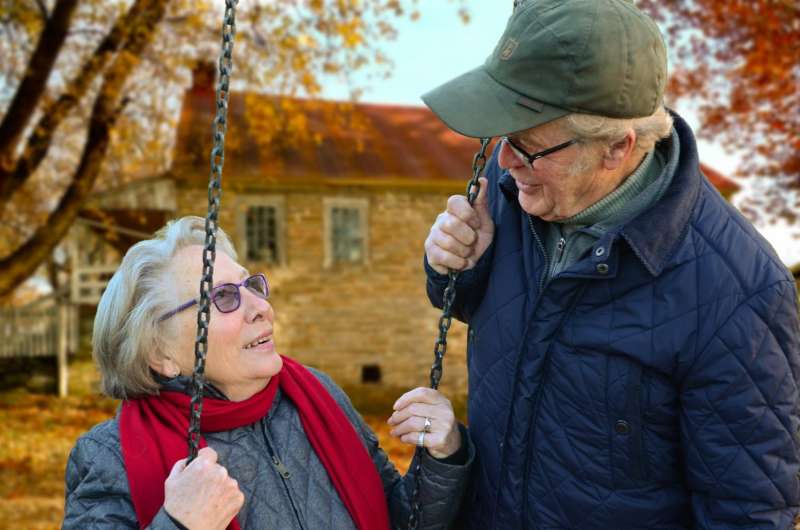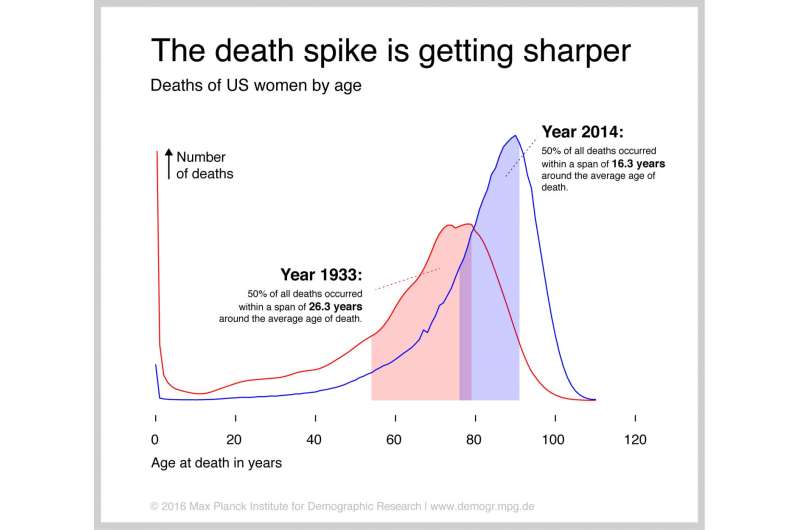As life expectancy grows, men still lagging

People worldwide are living longer, healthier lives. A new study of mortality patterns in humans, monkeys and apes suggests that the last few generations of humans have enjoyed the biggest life expectancy boost in primate history.
The gains are partly due to advances in medicine and public health that have increased the odds of survival for human infants and reduced the death toll from childhood illness. Yet males still lag behind females—not just in humans but across the primate family tree, the researchers find.
"The male disadvantage has deep evolutionary roots," said study co-author Susan Alberts, biology professor at Duke University.
The study will appear the week of Nov. 21 in the online early edition of Proceedings of the National Academy of Sciences.
An international team from the U.S., Germany, Denmark, Kenya and Canada compiled records of births and deaths for more than a million people worldwide, from the 18th century to the present. The data included people in post-industrial societies such as Sweden and Japan, people born in pre-industrial times, and modern hunter-gatherers, who provide a baseline for how long people might have lived before supermarkets and modern medicine.
The researchers combined these measurements with similar data for six species of wild primates that have been studied continuously for three to five decades, including Verreaux's sifaka lemurs, muriqui monkeys, capuchins, baboons, chimpanzees and gorillas.
The data confirm a growing body of research suggesting that humans are making more rapid and dramatic gains than ever before seen in the primate family tree.
For example, in the last 200 years life expectancy in Sweden has jumped from the mid-30s to over 80, meaning that a baby born today can hope to live more than twice as long as one born in the early 19th century. The data show that today's longest-lived human populations have a similar 40- to 50-year advantage over people who live traditional lifestyles, such as the Hadza hunter-gatherers of Tanzania and the Aché people of Paraguay.
In contrast, these modern hunter-gatherers—the best lens we have into the lives of early humans—live on average just 10 to 20 years longer than wild primates such as muriquis or chimpanzees, from which human ancestors diverged millions of years ago.
"We've made a bigger journey in lengthening our lifespan over the last few hundred years than we did over millions of years of evolutionary history," Alberts said.

One indicator of healthcare improvement is infant mortality, which strikes fewer than 3 in 1000 babies born in Sweden or Japan today. But it was more than 40 times higher for those born two centuries ago, and is still high among hunter-gatherers and wild primates.
The researchers also studied lifespan equality, a measure similar to income equality that indicates whether longevity is distributed evenly across society, or only enjoyed by a few.
They found that, for both humans and wild primates, every gain in average lifespan is accompanied by a gain in lifespan equality. That is, for a population to be very long-lived, everyone must benefit more or less equally, with fewer individuals left behind.
The researchers were surprised to find that the longevity of human males has yet to catch up with females, and the improvements in males aren't spread as evenly.
A girl born in Sweden in the early 1800s could expect to outlive her male counterparts by an average of three to four years. Two hundred years later, despite Swedes adding 45 years to their average lifespan, the gulf that separates the sexes has barely budged.
The life expectancy gender gap isn't just true for humans. Females outlived males in almost every wild primate population they looked at.
"It's puzzling," Alberts said. "If we can make life last so long, why can't we shrink the male-female gap?"
Numerous hypotheses have been proposed. Some pin the blame on genetics. Male primates, who carry only one copy of the X chromosome compared with two copies in females, lack a second X chromosome to compensate for any harmful gene variants their single X may have.
Another possibility, Alberts says, is that gender differences in risky behaviors like fighting continue to hold males back, even while deaths from infectious and chronic diseases that impact both sexes have declined.
If we can identify the culprit and intervene, Alberts says, we might be able to help men catch up.
More information: The emergence of longevous populations, PNAS, www.pnas.org/cgi/doi/10.1073/pnas.1612191113
Journal information: Proceedings of the National Academy of Sciences
Provided by Duke University




















